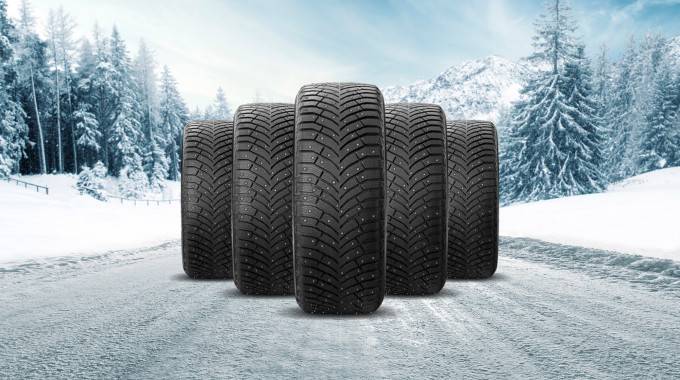
Hydroplaning Explained & 3 Ways to Help Prevent It
Hydroplaning can be a dangerous and potentially catastrophic situation. It’s essential to know what it is, how to help prevent it, and how to handle it if it happens to you.
What exactly is hydroplaning?
Also known as aquaplaning, it involves water - wet roads, puddles, or water on top of melting ice. If the tires ride over that water, instead of pushing it aside and staying in contact with the asphalt, your vehicle is hydroplaning.
The section of tire tread touching the road as you drive is the contact patch. On most tires, it isn’t much larger than the width of your outstretched hand. Those small patches are all that’s gripping the road when you’re accelerating, turning, or braking.

Photo: Goodyear Tires
Tire companies engineer tread patterns to handle different driving conditions. The tread’s components include tread blocks, the square or rectangular rubber blocks on the tread face; and sipes, small cuts in the blocks, which open when they touch the road surface for even more grip.
There are also grooves in the tire: large ones that run around the circumference, and smaller lateral grooves separating the tread blocks. These channel away water and slush.
How does hydroplaning feel when you’re driving?
If enough isn’t cleared away, the tire can actually ride up on top of the water. You may feel the steering wheel has no resistance and seems “light,” or the front end feels like it’s floating, or the vehicle moves sideways. You’ve lost control, and it’ll stay that way until the tire cuts back down through the water and once again makes contact with the asphalt.
Prevent hydroplaning: 3 things every driver should keep in mind
You should know how to avoid hydroplaning, and what to do if it happens. Here are tips:
Hold the wheel properly
Always use both hands, holding the wheel at 9 and 3 (even if you were taught 10 and 2). This gives you better control, allowing you to turn the wheel almost completely without adjusting your hands on it. If you drive with only one hand, you can’t steer as quickly and accurately when needed.

Photo: Skoda Motorsport
Pay attention to what’s under your tires. After a bit of practice, you’ll notice how the steering wheel feels on different surfaces – vibration on gravel roads, or jerking as snow ridges pull the tires, or less wheel resistance as the tires slide a bit on ice.
Pay attention to vehicle feedback
This is known as feedback, and while some vehicles “communicate” more than others (sports cars have a lot of feedback, while family vehicles tend to have less), if you know what the steering wheel is telling you, you’ll immediately identify that floating sensation as your tires start to hydroplane. The sooner you know it’s happening, the faster you can react.
Good tires are essential
If your tires are worn, the grooves are shallower and they simply can’t move as much water away from under them. Tires contain wear bars, which are rubber ridges cast across the tire’s width. They’re difficult to see when there’s lots of tread, but become more obvious as the tire wears. It’s time to replace your tires when the bars appear, for safety in all conditions.
Check your tire pressure with a gauge once a month, even if your vehicle has a tire pressure monitoring system (TPMS). Tires with too little or too much air don’t perform as well as properly-inflated ones. And switch to winter tires as needed.
Watch where you’re driving (and avoid cruise control)
Avoid driving through deep puddles if you can. If you can’t, reduce your speed before you get to the water, instead of braking once you’re in it. When roads are wet or slippery, slow down and leave more space from the vehicle ahead. Don’t use cruise control in poor conditions. This is a job for a human who can look ahead and stay clear of problems.
What to do when hydroplaning on wet road conditions
Gentle deceleration over braking
If you feel that floating sensation of hydroplaning, stay calm and do not brake. Abrupt changes in speed or steering can cause loss of control. Instead, immediately take your foot off the throttle. That gentle deceleration is usually enough for the tires to break through the surface and contact the road again. If you’ve familiarized yourself with steering wheel feedback, you’ll feel the grip return.
Wait for tires to grip before any hard steering
If you’re on a curve, then as your vehicle slows down, make gentle adjustments to follow the curve. If the vehicle doesn’t obey, don’t steer any harder, but wait for the tires to grip. If you’ve previously turned the wheel all the way to the corner, turn it a bit in the opposite direction. It sounds weird, but straightening out your tires this way helps them regain their grip.
It takes a lot to describe, but all of this usually happens over a few seconds. What you do in those quick moments can make all the difference. Be aware, don’t panic, make the right moves, and you’ll be back on track in no time.
To learn more about the different types of tire for the seasons, read our Buyer's Guide: All-Season vs. All-Weather vs. Winter (or Snow) Tires.







